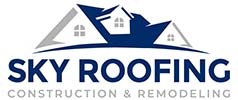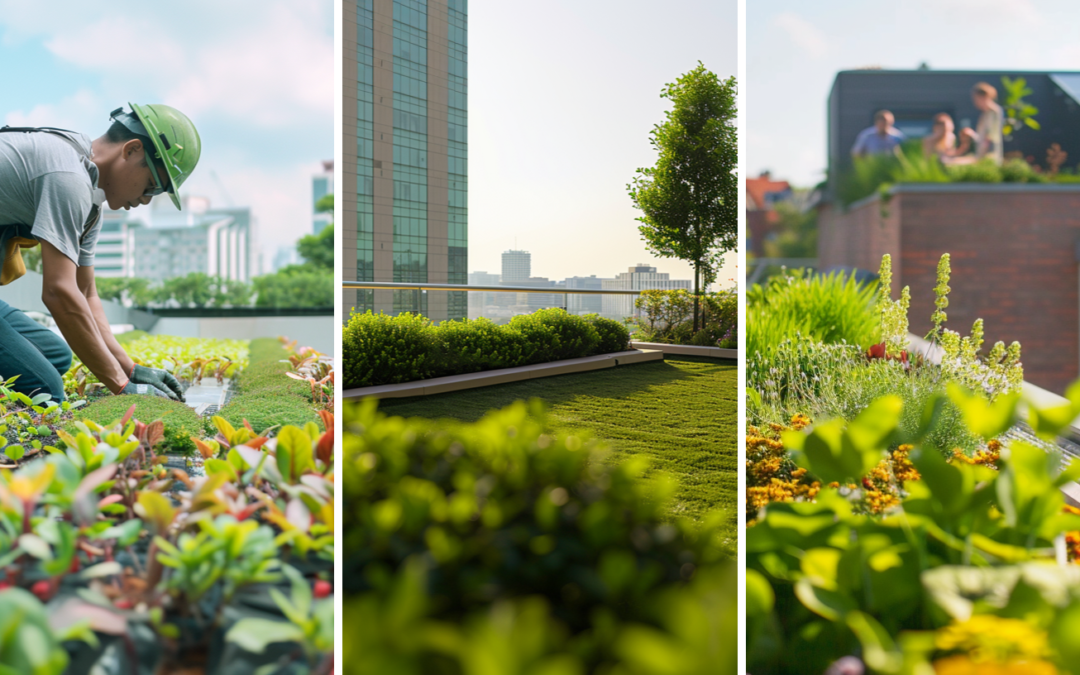Introduction to Green Roofing
The primary purpose of green roofing is to enhance the functionality and aesthetics of a building while also providing numerous benefits for the environment and property owners. These benefits include but are not limited to, improved insulation, reduced energy costs, increased biodiversity, and improved air quality. Green roofing can also help mitigate stormwater runoff, reduce the urban heat island effect, and extend the roof’s lifespan by protecting it from weathering and UV radiation. Implementing green roof technology is a testament to modern sustainable architecture’s innovation and forward-thinking approaches.
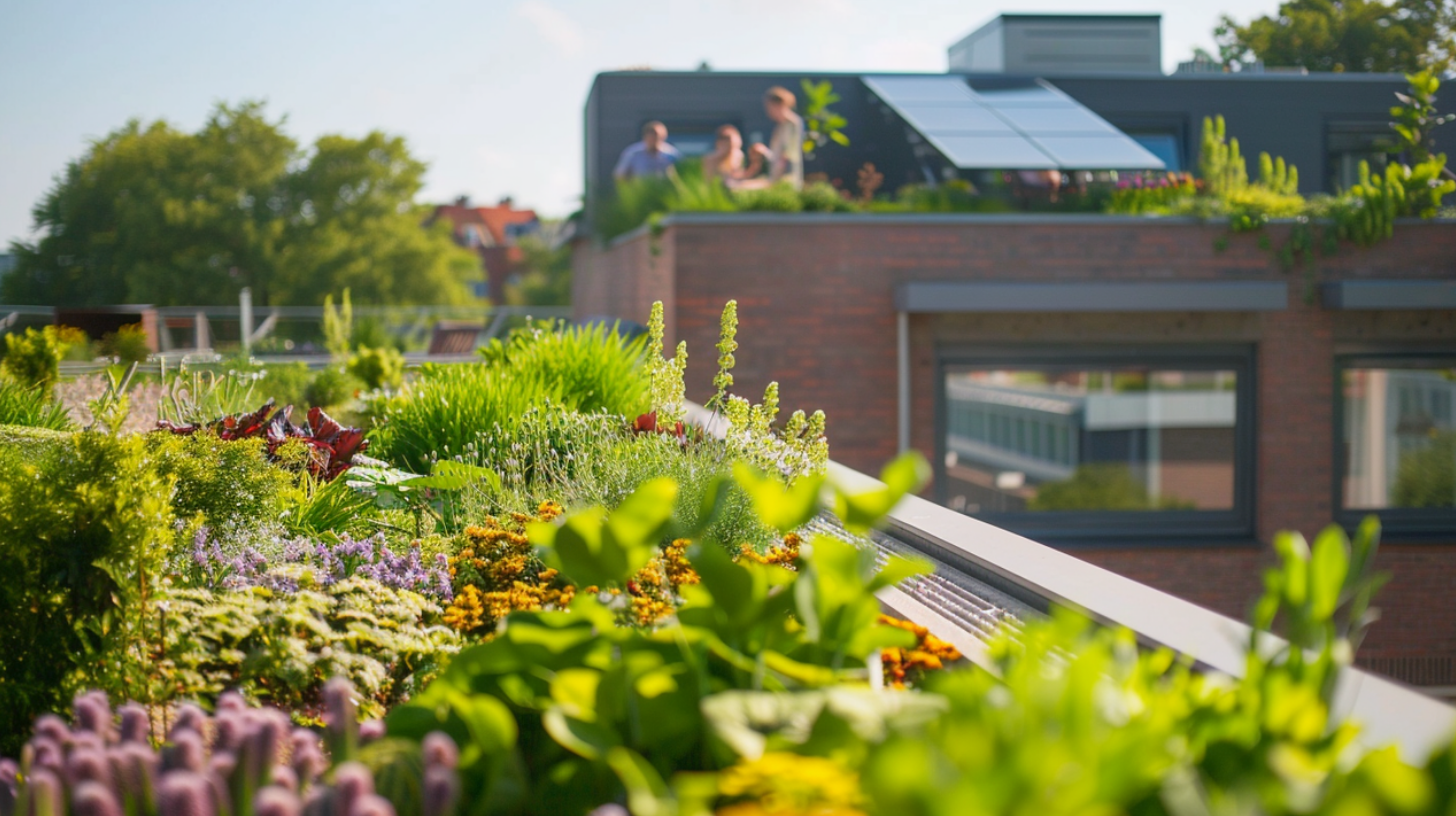
Green Roofing - Why Choose Green Roofing - Sky Roofing Construction & Remodeling
Why Choose Green Roofing?
Environmental Benefits
Another advantage is the reduction of urban heat islands. Green roofs cool urban areas by mitigating the heat trapped between buildings and pavement. The vegetation and soil on green roofs help to dissipate heat and reduce energy consumption for air conditioning, ultimately decreasing the urban heat island effect.
Furthermore, green roofs improve air quality through plant photosynthesis. By absorbing carbon dioxide and releasing oxygen, they offer a natural way to purify the air. This process helps combat air pollution, resulting in cleaner and healthier environments.
Green roofs also provide energy efficiency benefits by regulating building temperatures. The vegetation acts as an insulator, reducing the need for winter heating and summer cooling. This, in turn, lowers energy consumption and greenhouse gas emissions.
Lastly, green roofs support biodiversity and provide habitats for pollinators. They offer a space for plants, insects, and birds to thrive in urban environments, promoting biodiversity and enhancing the overall ecological balance. By fulfilling these vital environmental functions, green roofs contribute significantly to sustainable urban development and the well-being of city inhabitants.
Economic Benefits
Beyond energy savings, green roofing can also lower maintenance costs for building owners due to its extended lifespan compared to traditional roofing materials. The vegetation provides a protective layer, shielding the roof from harmful UV rays and extreme weather, which reduces the need for repairs and maintenance over time. Moreover, green roofs absorb rainwater, minimizing stormwater runoff and the need for expensive drainage systems.
Green roofing is also a wise and cost-effective investment for those looking to increase their property value. Green roofs’ sustainable and eco-friendly nature appeals to environmentally conscious buyers, driving up property values. As awareness of climate change and sustainable living grows, properties with green roofs are becoming highly sought after. This demand, coupled with the ecological benefits such as improved aesthetics, noise reduction, and potential tax incentives, makes green roofing a smart financial choice.
Furthermore, green roofs offer the potential for various products derived from the vegetation they support. Local businesses can generate revenue from plant-based products and agricultural goods like herbs, flowers, or even small-scale crops. This creates economic opportunities and provides residents access to fresh, locally grown produce, promoting sustainable living and strengthening the local economy. The cost-effective nature of green roofing makes it an attractive option for property owners and a valuable asset to communities.
Social Benefits
By incorporating green roofs into buildings, we can transform once-ordinary rooftops and unused spaces into vibrant spaces that unite people. These roof gardens and green spaces provide neighbors and community members opportunities to connect and engage with each other. They serve as gathering spots for social events, such as community gardening projects, outdoor yoga classes, or even small concerts.
Additionally, green roofs can also serve as educational and recreational spaces. They offer a unique opportunity for individuals to learn about sustainable practices, gardening techniques, and the importance of biodiversity. Educational programs and workshops can be organized on green roofs to promote environmental consciousness and equip individuals with valuable knowledge and skills.
Green roofs in urban areas can also improve mental health and overall well-being. Research has shown that being in nature and green spaces can reduce stress and anxiety. By providing access to green areas, green roofs allow individuals to find tranquility amidst the hustle and bustle of city life. Utilizing previously unused spaces for green roofing transforms them into assets that enhance social interaction, education, and mental health, enriching the urban experience for all residents.
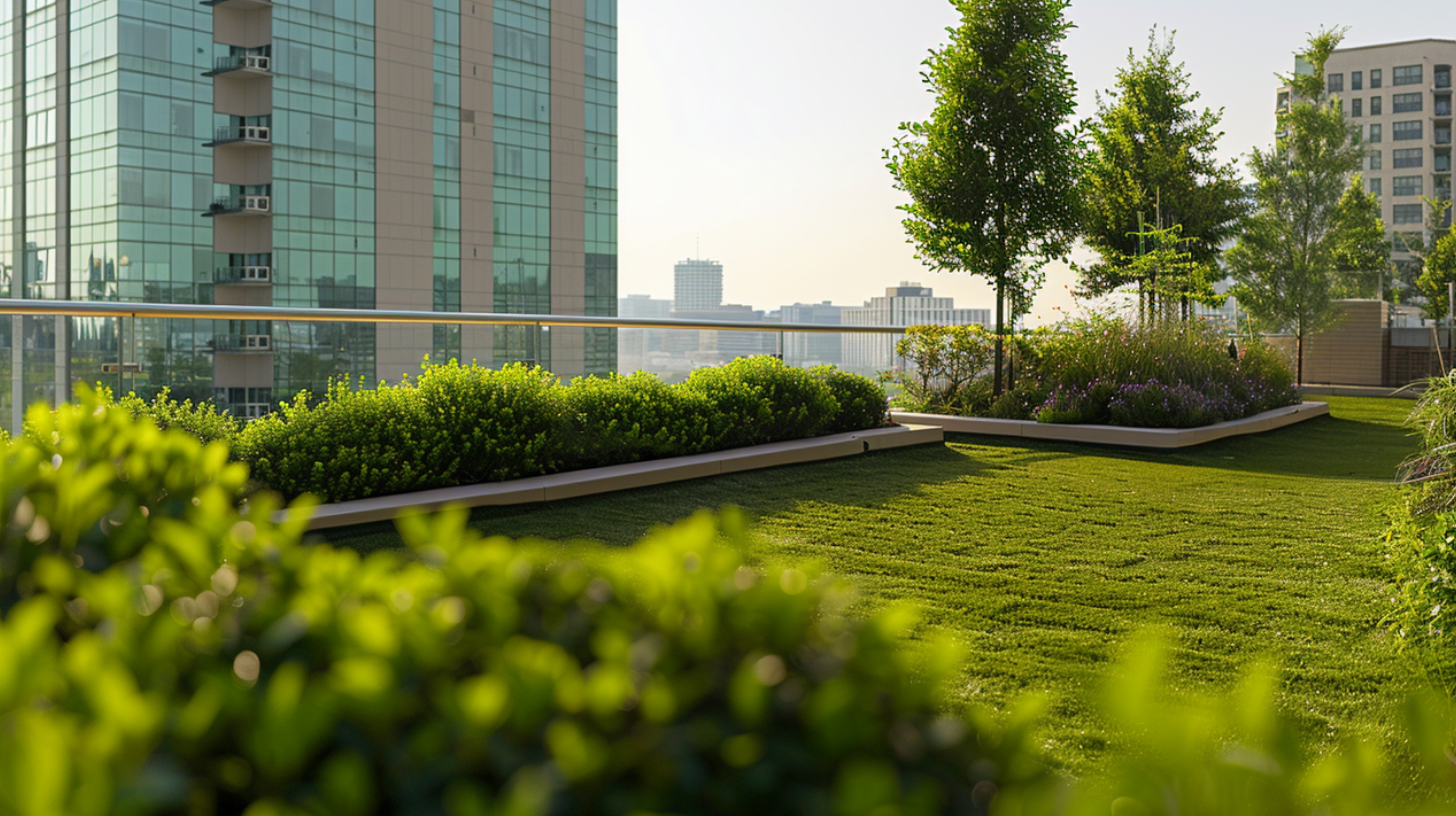
Green Roofing - Types and Variations of Green Roofs - Sky Roofing Construction & Remodeling
Types and Variations of Green Roofs
Extensive Green Roofs
An extensive green roof is a type of green roof that requires minimal maintenance and is specifically designed to be lightweight. Unlike intensive green roofs, which require regular care and can support a variety of plants and even trees, extensive green roofs have a thinner layer of soil and primarily support low-growing plants such as sedums and succulents.
The key characteristic of extensive green roofs is their ability to thrive with minimal intervention. Compared to other green roofs, they require much less water, fertilizer, and maintenance, making them an excellent choice for those seeking a low-maintenance solution.
Extensive green roofs offer numerous benefits in addition to their low-maintenance nature. They provide excellent insulation, helping to regulate the temperature and reduce energy consumption within the building. Their lightweight nature also minimizes structural stress and extends the roof’s lifespan.
Another advantage is their contribution to biodiversity. These roofs provide a habitat for birds, bees, and insects, supporting local ecosystems and promoting a healthier environment.
Moreover, extensive green roofs efficiently use roof space, transforming unused areas into productive, green habitats. This not only enhances the aesthetic appeal of buildings but also maximizes the utility of the roof space, contributing to the overall value and functionality of the property.
The extensive type is an excellent option if you consider installing a green roof. Its low-maintenance, lightweight, and biodiversity benefits make it an attractive choice for home and building owners looking to embrace sustainability and enhance their property’s surroundings.
Semi-Intensive Green Roof
Unlike extensive green roofs, which primarily consist of low-growing sedum and require minimal maintenance, and intensive green roofs, which involve deeper soil and allow for the growth of larger plants and even trees, a semi-intensive green roof strikes a balance between the two. It allows incorporating a wider range of plants, such as grasses, shrubs, and flowering perennials, creating a more diverse and visually appealing landscape.
Thanks to its hybrid nature, a semi-intensive green roof provides the flexibility to design and customize the roofscape according to individual preferences. While still relatively low-maintenance compared to an intensive green roof, it offers more room for creativity and personalization.
Semi-intensive green roof installations allow property owners to enhance their buildings’ ecological value and aesthetic appeal. These installations can transform urban environments by offering lush green spaces that support biodiversity and contribute to residents’ well-being. The versatility and adaptability of semi-intensive green roofs make them a compelling choice for those looking to balance practicality and beauty in their green roof projects.
Intensive Green Roof
Distinguished by their substantial soil depth, typically 6 to 18 inches, intensive green roofs can support various plant species, from grasses and shrubs to trees and even urban gardens. This ample soil depth allows for more complex root systems and creates an ecosystem resembling a natural garden or park.
Compared to other green roofs, intensive green roofs offer increased stormwater retention, improved insulation, and noise reduction. Furthermore, these roofs provide incredible biodiversity, contribute to improved urban cooling and air quality, and can even foster local food production in urban areas.
However, it is essential to note that intensive green roofs require additional considerations during installation and regular maintenance. Given the substantial soil and plant life weight, structural adjustments may be necessary. Working closely with a qualified roofing contractor is essential to ensure proper structural support and integrity throughout the installation process.
Maintenance requirements for intensive green roofs are also more intensive, as the plants need regular pruning, fertilization, and irrigation. Periodic inspections of the roof’s integrity are crucial to avoid potential issues. Selecting appropriate plant species that thrive in the local climate and conditions is vital for the long-term success of intensive green roofs. Working with experienced professionals in plant selection and roofing contractors ensures that these roofs meet environmental goals and maintain their functionality and beauty over time.
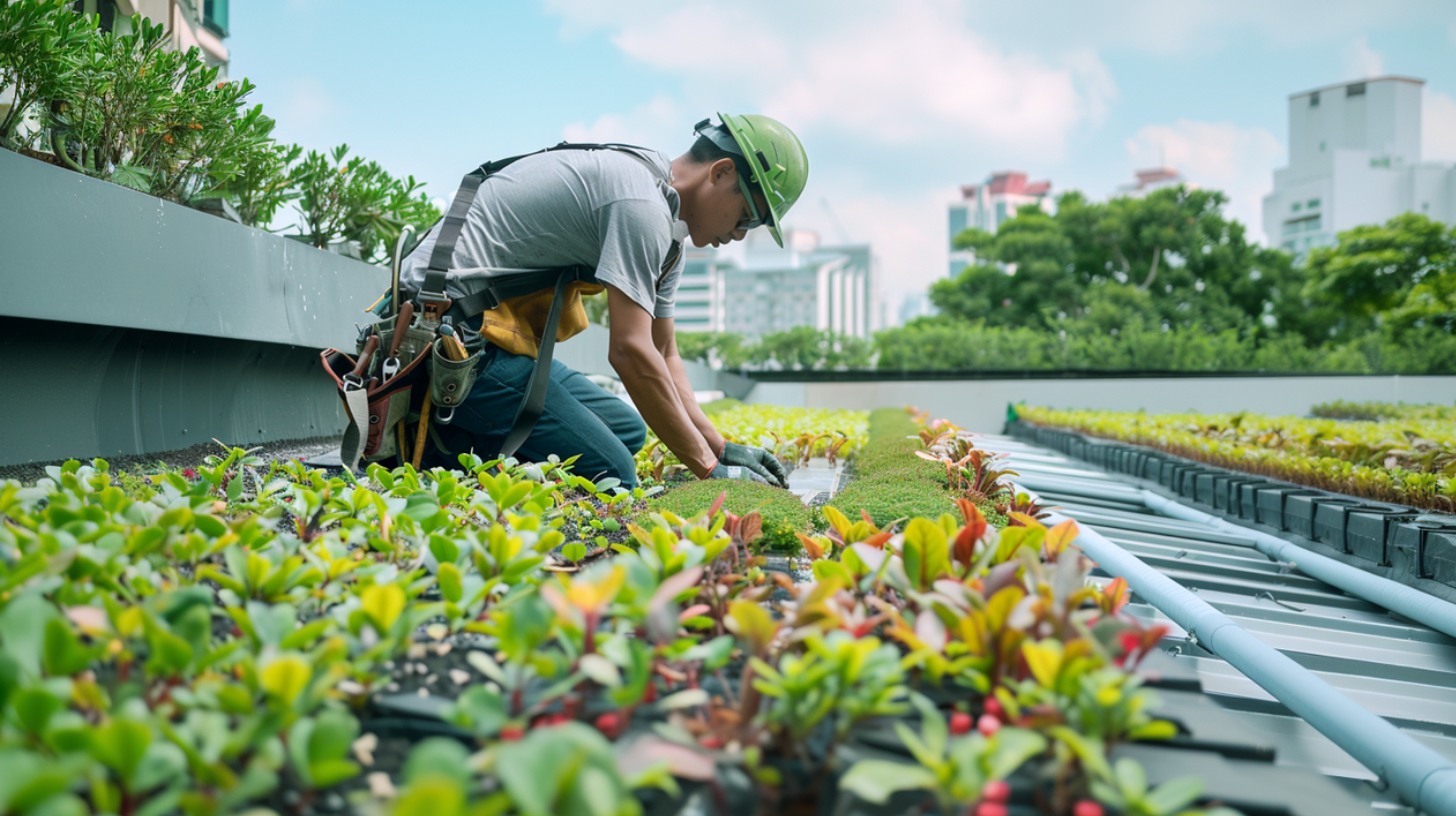
Green Roofing - Components of a Green Roof - Sky Roofing Construction & Remodeling
Components of a Green Roof
The first component of a green roof is the root barrier layer. This layer prevents plant roots from penetrating the roof, protecting its structural integrity. Next, the drainage or water storage layers manage excess water by allowing it to drain through the roof or be stored for later use. These drainage layers prevent water from pooling on the roof surface and reduce the risk of leaks, ensuring the longevity of the roof structure.
The growing media, referred to as substrate or soil, acts as a growing medium for plants. It is a lightweight blend of organic matter and inorganic materials that provides nutrients, support, and moisture retention for vegetation to thrive. The choice of growing media depends on the specific design goals and plant species being used.
Finally, vegetation is a critical component of a green roof. It consists of specially selected resilient, drought-tolerant plants that can thrive in the rooftop environment. These plants help regulate temperature, improve air quality, absorb rainwater, and provide biodiversity in urban areas.
When planning green roof installations, it’s essential to consider the compatibility of these components with the existing roof structure. Working with knowledgeable roofing contractors ensures that the integration of drainage layers and other components aligns with the building’s structural requirements, ensuring the effectiveness and longevity of the green roof system.
Cost Analysis and Return on Investment for Green Roofs
While the initial cost of installing a green roof may seem higher than traditional roofs, its financial benefits can provide a substantial ROI. One of the significant advantages is the potential increase in property value. Green roofs are viewed as desirable and environmentally friendly additions, driving up the value of a property. Research has shown that green roofs can increase property value by up to 15%.
Moreover, green roofs contribute to energy savings. The added insulation provided by the layer of vegetation and soil helps regulate indoor temperature, reducing the need for heating and cooling, resulting in lower energy bills. Additionally, green roofs absorb and filter rainwater, decreasing the burden on stormwater management systems, which can lead to cost savings for the building owner. Considering the long-term financial benefits, green roofs can be a wise investment despite the higher initial costs.
Embrace Green Roofing with Sky Roofing Construction & Remodeling
Green roofing presents a transformative solution for enhancing buildings’ sustainability and functionality while positively impacting the environment. Green roofing mitigates urban heat islands, improves air quality, and promotes biodiversity by incorporating rooftop vegetation. It also offers substantial economic benefits such as energy savings, reduced maintenance costs, and increased property value. Whether you’re looking to install an extensive, semi-intensive, or intensive green roof, Sky Roofing Construction & Remodeling (https://www.skyroofingconstructiontx.com/) is here to help. Contact us today at (210) 942-9797 to schedule a consultation and explore how green roofing can elevate your property’s appeal and environmental footprint.
Willis Vachon is a seasoned contributing writer for Sky Roofing Construction & Remodeling, specializing in the technical and safety aspects of roofing construction. With a keen eye for detail and a passion for ensuring quality and safety in every project, Willis provides valuable insights that help both professionals and homeowners make informed decisions about their roofing needs.
